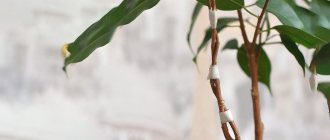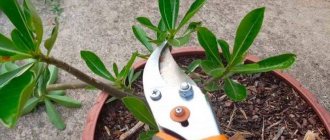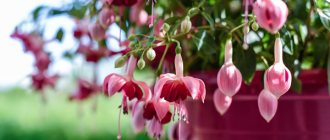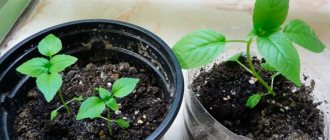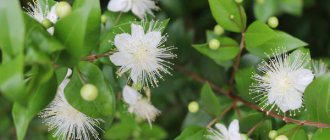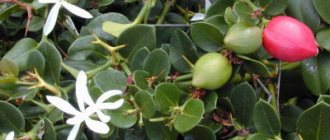How to properly form a plant
The plant is distinguished by interestingly shaped flowers that combine several shades. On each branch several thinner stems are formed, on each of which 3-10 inflorescences subsequently develop. The flowers have an outer row of strongly expanding pointed petals, several rows of rounded small petals and long stamens at the core. Each of these parts may be different from the others in color, blue, yellow, white, pink, red or purple.
Note! There is no single requirement on how to form a fuchsia bush correctly. The crown can have any shape depending on your own wishes.
Pruning is necessary to remove the weakest shoots that will bloom poorly. For example, you can immediately remove stems that are too long and thin or those that have only a couple of small leaves, while the rest are distinguished by an abundance of greenery. It is also necessary to trim stems that have become woody over time. Only the trunk of the bush cannot be trimmed.
Fuchsia
Features of the flower
There are a huge number of fuchsia varieties. The plant has a variety of flowers, which can be simple or double. In some types of fuchsia, flowers are collected in inflorescences. The plant is characterized by the presence of small foliage, the length of which can reach five centimeters. The leaves of the crop are colored bright green. The leaves are oval in shape and slightly pointed at the ends.
The color of the flowers of a plant can be varied, which allows the gardener to choose the most suitable option in accordance with the landscape design. In their shape, flowers can resemble bells or dancing ballerinas. The place where petals are formed is the tubular corolla. When the flowers are in full bloom, they resemble fluffy skirts. The decorative effect of the flower is ensured by the presence of long stamens. Fuchsia is a rather attractive flower that any gardener dreams of placing in his garden.
Fuchsia has faded: what to do next
Fuchsia seeds - cultivation
What to do with fuchsia after flowering? It is necessary to partially cut the stems, this will have a beneficial effect on subsequent flowering. It is better to prune twice: in early autumn and in mid-spring. First of all, wilted or shriveled stems are removed. After this, young shoots and branches at the ends should be trimmed. Next, the fuchsia is trimmed based on decorative preferences, that is, the desired crown shape is set.
Note! Fuchsia can easily curl around a support. It is often braided so that the stems grow in the right direction. Young stems can be intertwined with each other so that they form one low trunk of an interesting shape.
When pruning fuchsia in autumn, it is important to inspect the branches for the presence of harmful insects or diseases affecting the bark. If something like this is actually found, the diseased branch and its small healthy part will have to be removed.
Pruning Fuchsia
Pruning after flowering
After the bush has flowered, it is recommended to partially cut off the branches. This will allow the bush to gain strength. The procedure is carried out twice a year: in September and April. First, all wilted and dry stems are removed from the plant. The next step is for the gardener to cut off all the young shoots. Then the fuchsia is formed to the desired shape. The plant can wrap around supports. Therefore, the stems can be braided or intertwined with each other. In the fall, the gardener should inspect the fuchsia for the absence of pests and diseases. If detected, the diseased branch should be cut off, including the healthy part.
How to form fuchsia on a trunk: pruning scheme, recommendations
Diseases and pests of fuchsia
What to do next when the fuchsia has faded? After the fuchsia has faded, the faded cuttings and twigs that have formed above the young buds are removed.
The standard is formed from a healthy cutting with a strong, straight stem. When planting, it is necessary to install a stick to support the main trunk. Next, you need to figure out how to shape the planted fuchsia. To start forming fuchsia on a trunk, you first need to let it grow to the desired height, cutting off all the side shoots. When the stem reaches the desired height, the top is cut off, and immediately after this young side shoots begin to form. By pinching them, you can get a lush flowering bush.
Forming a fuchsia crown is easy; this way you can give it a certain shape. For example, you can give it the shape of a heart, a ball or a small tree, based on the calculation that from each cut piece two more will grow. They will be directed towards the angle at which the trim was made.
Fuchsia pruning scheme
Features of reproduction
Fuchsia ampelous can reproduce in several ways. Most often, cuttings or seeds are used for this purpose. The first method is simpler, which is explained by the fastest rooting of the flower. To carry out the procedure, it is recommended to give preference to young cuttings, the length of which is 7-15 centimeters.
It is necessary to remove the lower foliage from the cuttings and place them in water. Storage of cuttings should be carried out at room temperature. After a week, roots appear on the cuttings. During this period, the material is planted in the soil mixture.
There is another way to propagate ampelous fuchsia, which involves planting cuttings in the substrate immediately after cutting. To avoid loss of turgor by the foliage of the cutting, the container with it must be placed in a greenhouse. After the roots appear, the plants are removed from the greenhouse for a short period of time. To ensure optimal adaptation of the plant, it is necessary to gradually increase the time it stays under normal conditions.
If cuttings are used to propagate the crop, then this procedure can be carried out at any time. But it is best to carry out propagation in the spring, which is explained by the presence of optimal conditions for the flower. If the procedure is carried out in the summer, then against the backdrop of high temperatures, rotting of the cuttings may occur.
To obtain seeds at home, fuchsia is artificially pollinated. If cross-pollination is carried out, this will lead to the production of new plant hybrids. Several weeks after the procedure, the ripening of the plant fruit will be observed. It must be cut and the seeds removed. After drying, the seeds are planted in the ground.
For planting seeds, a traditional substrate is used, which is pre-moistened. The material is dispersed over the soil surface. Place film or glass over the seed container. The container is installed in well-lit places. After two weeks, as a rule, the appearance of the first shoots is observed. After several months have passed, it is necessary to pick up the seeds. They should be planted separately at a short distance. After several months, the seedlings are planted in separate cups.
Propagation of fuchsia is a fairly simple procedure, which is explained by the complete establishment of the plant.
Pinching and forming a fuchsia cutting
Why do fuchsia leaves wither and fall off?
You should not pinch the plant too often, at least you should be careful with this before flowering begins. Pinching involves cutting off young shoots and leaves. The ends of very thin branches that have recently formed are cut off, so the tree’s energy is not used to grow greenery that is useless this season, but to ensure that the flowers are large and bloom well. Thanks to pinching, crown growth slows down; it should be done about once every two weeks throughout the summer. Already in the fall, you can do a full crown pruning, without reducing the number of flowers on the bush. Fuchsia, pruned and pinched correctly, will bloom much more abundantly, more luxuriantly and a little longer.
Note! You need to know how to pinch fuchsia so that it produces as many flowers as possible. The main shoot needs to be cut at an angle, soon two more young ones will appear from it, do the same with them.
A correctly pruned bush is overgrown with many young shoots, at the end of each of which inflorescences form. Basically, it is on young shoots that buds are formed, that is, in order to get a profusely flowering bush, you need to cut off the maximum number of stems from which new ones will appear
Pinching and forming a fuchsia cutting
Growing conditions
Fuchsia ampelous is a soil-unpretentious flower. That is why it can be planted in almost any soil mixture. In most cases, plants are grown in pots that are pre-filled with universal soil. It is best to give preference to a soil mixture with a loose structure. Sand, peat or ash must be added to it. The substrate can be prepared independently from:
There is another option for preparing a substrate from humus, turf soil, compost, and peat.
In order to provide optimal conditions for the flower, it is necessary that there be high air humidity indoors or outdoors. That is why it is recommended to place a container pre-filled with water near the pot. Flower growers are also recommended to regularly spray the crop.
Fuchsia should be placed in moderate lighting conditions. At the same time, flower growers make sure that the flower is not constantly in shading conditions. The location of the culture should be a balcony or western, eastern windows. This will provide adequate lighting to the plant in the morning and evening.
To ensure that the crop produces the optimal number of inflorescences, a certain temperature regime is observed. During the daytime, the air temperature must be between 20 and 22 degrees. At night, it is necessary that it decreases by 4 degrees. At excessively high temperatures, there may be no flowering, which will negatively affect the decorative qualities of the plant. Also, if this condition is not met, the crop may shed its leaves.
Providing optimal conditions is the key to the success of full growth and flowering of fuchsia.
Wintering fuchsia in open ground. Winter pruning rules
In most cases, gardeners are advised to dig up fuchsia for the winter and leave it in pots indoors or at home; fortunately, this is not so difficult to do. This will protect the tree from frost by keeping it warm. If the bushes have already reached quite large sizes or there are a lot of them on the site, it will not be possible to store them indoors. In this case, you can simply cover the plants with spruce branches or spunbond. They should survive the winter well. Some varieties need to be cut almost to ground level, covered generously on top, sometimes even sprinkled with 10-15 cm of soil. At the end of spring, the plants are dug up, after which they begin to grow again.
Note ! Annual varieties of fuchsia do not need to be left for the winter; instead, cuttings will have to be re-rooted every year.
Secrets of cultivation
In order for a plant to grow and develop quickly, certain aspects must be taken into account. For example, if the summer is excessively hot, then it is recommended to remove the pot with the crop indoors and place containers with ice around it. To grow flowers, it is best to use ceramic rather than plastic pots. This is explained by the fact that in the summer the root system in them will heat up less.
Like any other plant, fuchsia can be damaged by pests. The most common sighting on a flower is the whitefly. These are miniature flies, white in color. If the plant is shaken, the pest will fly off. The whitefly sucks the sap from the plant, which leads to wilting and drying of the foliage. To combat this pest, it is necessary to use appropriate insecticides. The most frequently used drugs are Aktelik and Aktara. These drugs must be alternated.
If there is increased air or soil humidity, this can lead to powdery mildew. The fight against this disease is carried out with Fundazol or Topaz. A short flowering period of a crop may indicate excessive watering or insufficient fertilizer. In some cases, red spider mites appear on the underside of the crop. When this pest appears, rare pale spots are observed on the foliage, which after a certain time form a single spot. This pest causes yellowing and dying of foliage. Its appearance can be diagnosed against the background of high temperature or dry air. Pest elimination is carried out by Confidor or Agravertin.
Ampelous fuchsia is a very beautiful flower, which can be grown in the garden or on the balcony. In order for a crop to grow fully, it is necessary to provide it with optimal growing conditions. Fuchsia also requires minimal care, which consists of timely watering, pruning, and fertilizing. In order for the crop to bloom fully, it is recommended to provide it with proper wintering. When pests appear, it is necessary to combat them, which will limit the possibility of the flower dying off.
Useful tips for gardeners on pruning and shaping fuchsia bushes
Many people are interested in how to prune fuchsia at home and whether it should be done at all. Pruning fuchsia at home should be done less often than when growing in open ground. A significant difference will be the size of the bush and the thickness of the stems. If in natural garden conditions you can get a bush-shaped tree 1.5 m high, then at home a small bush no more than 20-30 cm will grow.
Important! We need to figure out how to prune such a small fuchsia without cutting off excess stems. The pruning scheme is the same as for large bushes; young shoots are cut off by 1-2 cm so that several new ones grow in their place.
Growing fuchsia at home is a little easier due to the absence of the need to replant for the winter, and the temperature regime will not change so much throughout the year. And in summer, the scorching sun will not fall on the flower, whose rays often burn through the delicate leaves of fuchsia growing in its natural environment.
Plants that have miniature shapes and small leaf sizes, as well as the flowers themselves, require much less effort and can bloom much earlier than other varieties. They do not require as much care and will bloom even in not the hottest climates.
5 1 vote
Article rating
Formula 2:4:8:16:32.
The formula is completely simple and is based on the principles described above.
- Let's say you have a cutting that has one growing point - a stem that grows exclusively upward.
- You must decide how many nodes to leave - for example, 3. After the third internode, cut the stem, 1 cm away from the node.
- From the last node you will receive 2 new branches from awakened buds.
- As soon as 1-2 internodes grow on these 2 branches, you make a cut again. At the site of each cut, 2 more branches grow - a total of 4.
- Thus, after each cut the number of branches doubles - 2: 4: 8: 16: 32: 64, etc.
Diseases
Fuchsia rarely gets sick, most often this happens due to improper care after pruning. The most common ailments:
- Rust. Brown spots on the inside of the leaf are a clear sign of this disease. It could have gotten onto the plant due to poor disinfection of instruments. To get rid of the disease, you must urgently remove the infected leaves and treat with Bordeaux mixture at intervals of 2-3 days.
- Root rot. Appears as a result of excessive moisture. If dark brown roots are noticed during transplantation, this means that the flower has been affected by rot. Such a fuchsia cannot be saved; the only thing that can be done is to cut the cuttings and root them.
- Chlorosis. A flower can get chlorosis if it is watered with tap water. The main symptom is yellowed leaves. To return to a healthy appearance, you need to review the watering regime.
Season selection
So, from the above it is clear that pruning for fuchsia is a useful and necessary procedure. When is the best time to do it?
- Very often this is done in the spring, before new buds appear. If you prune according to the instructions, the fuchsia will delight you with bright and lush flowering.
- As for the autumn period, it is best to wait until the end of October - beginning of November. It is in the fall that it is recommended to prune the fuchsia contained in the apartment. The procedure consists of removing parts of the branches where the flowers were located, as well as shortening the shoots to the first pair of leaves with stone buds from the top.
- If you are the owner of one of the varieties of fuchsia that blooms until late autumn, you can prune it for the winter. However, most often bushes that are sent to spend the winter in the basement, cellar, or balcony (for example, were dug up from a flower bed) undergo such a “haircut.” It is recommended to shorten the branches, leaving them only 1/3 of their length (but not more than 15 cm).
